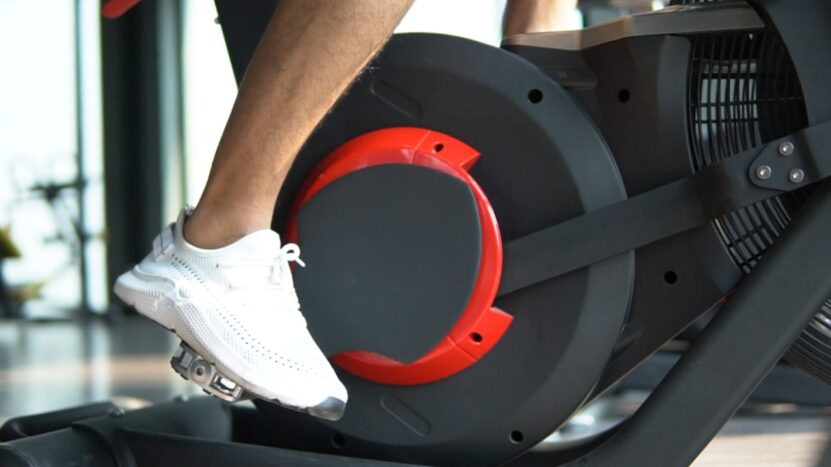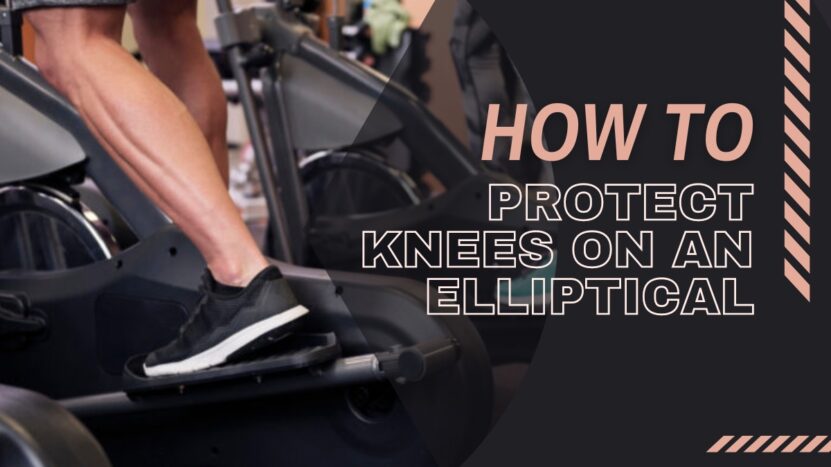Ellipticals have become a staple in gyms and homes across the globe due to their numerous health benefits and low-impact nature. However, it’s crucial to take proper precautions to protect your knees when using this equipment.
In this comprehensive guide, we will explore various strategies to ensure that you can enjoy a safe, effective, and pain-free workout on an elliptical. From footwear to strength training exercises, our goal is to provide you with valuable insights and practical tips to safeguard your knees and get the most out of your exercise routine.
Wear Proper Footwear

One of the most crucial factors in protecting your knees on an elliptical is wearing the right footwear. Shoes with adequate support, cushioning, and stability can significantly reduce the stress placed on your joints during your workout. When selecting your footwear, consider the following:
- Opt for shoes specifically designed for elliptical use or cross-training, as these provide the necessary support for the side-to-side and forward-and-backward movements.
- Look for a shoe with a firm, supportive arch, and a well-cushioned heel to absorb the impact of each stride.
- Ensure a comfortable and snug fit, as a loose shoe can cause instability and put additional strain on your knees.
By investing in proper footwear, you’re taking a critical step towards protecting your knees and enhancing your overall elliptical experience.
Use Knee Pads
While not a common accessory for elliptical workouts, knee pads can provide an additional layer of protection for your knees. This is especially beneficial if you have a history of knee problems or are recovering from an injury. When choosing knee pads, look for the following features:
- Breathable materials that wick away sweat and moisture to keep you comfortable during your workout.
- A snug yet flexible fit that allows for a full range of motion without causing discomfort or restricting movement.
- Adequate padding and support to reduce the impact on your knees during your elliptical session.
Adjust Elliptical Settings

The proper adjustment of the elliptical settings can make a significant difference in protecting your knees. Here are some guidelines to help you find the right settings for your body and fitness level:
- Choose an appropriate stride length that allows you to maintain a comfortable and natural gait. If the stride is too long, it can strain your knees and lead to discomfort.
- Adjust the foot pedal angle to a position that supports your natural foot alignment and reduces stress on your joints.
- Use the incline setting to target different muscle groups and vary your workout intensity without adding unnecessary pressure on your knees.
Start with Low Resistance
Beginning your elliptical workout with low resistance is essential for protecting your knees, particularly if you’re new to this form of exercise. Lower resistance levels reduce the strain on your joints, allowing your body to gradually adapt to the movements and build strength. As your fitness level improves, you can slowly increase the resistance to challenge your muscles without compromising knee safety.
Avoid Excessive Speed
Maintaining a moderate pace during your elliptical workout is vital for knee protection. Excessive speed can increase the impact on your joints, leading to discomfort and potential injury. Focus on maintaining a steady, controlled rhythm and prioritize proper form over speed. By doing so, you’ll not only protect your knees but also maximize the effectiveness of your workout.
Use Proper Form
Using the correct form on the elliptical is crucial for protecting your knees and ensuring an efficient workout. Here are some tips to help you maintain proper form:
- Keep your head up, shoulders back, and chest open to promote proper posture and alignment.
- Engage your core muscles to stabilize your torso and support your lower back.
- Distribute your weight evenly on the foot pedals and avoid leaning heavily on the handlebars, which can place undue stress on your knees and lower back.
- Move your legs in a smooth, fluid motion to minimize joint impact and encourage proper muscle engagement.
By focusing on proper form, you’ll reduce the risk of knee injuries while also improving the overall effectiveness of your elliptical workout.
Gradually Increase Resistance and Duration
As your fitness level and strength improve, it’s essential to gradually increase the resistance and duration of your elliptical workouts to continue challenging your body. However, it’s crucial to do so in a controlled and measured manner to avoid placing unnecessary stress on your knees.
Start by increasing the resistance by small increments and assess how your knees respond. Similarly, slowly extend your workout duration by adding a few minutes each week. This progressive approach allows your body to adapt to the increased demands without compromising knee safety.
Incorporate Strength Training Exercises

Including strength training exercises in your overall fitness routine can help protect your knees by developing the muscles that support the joint. Focus on exercises that target the quadriceps, hamstrings, glutes, and calf muscles. Some examples of effective exercises include:
- Squats
- Lunges
- Leg presses
- Calf raises
- Hamstring curls
By incorporating strength training exercises into your regimen, you’ll improve your knee stability and reduce the risk of injury during your elliptical workouts.
Stretch Before and After Use
Stretching is a vital component of protecting your knees and optimizing your elliptical workout. A proper warm-up that includes dynamic stretches helps prepare your muscles and joints for the demands of the exercise.
After your workout, static stretches can aid in recovery and reduce the risk of injury by promoting flexibility and range of motion. Focus on stretches that target the muscles surrounding the knee joint, such as the quadriceps, hamstrings, and calves.
Take Breaks and Rest When Needed
Lastly, it’s essential to listen to your body and take breaks or rest days when needed. Overworking your muscles and joints can increase the risk of knee injuries and hinder your overall progress. Incorporate rest days into your exercise routine and be mindful of any signs of discomfort or pain during your elliptical sessions.
If you experience persistent knee pain, consult with a healthcare professional to ensure you’re taking the appropriate measures to protect your joint health.
FAQs
What strength training exercises can help protect my knees during elliptical workouts?
Focus on exercises targeting the quadriceps, hamstrings, glutes, and calf muscles, such as squats, lunges, leg presses, calf raises, and hamstring curls. Incorporating these exercises into your regimen improves knee stability and reduces the risk of injury during elliptical workouts.
Why is stretching important for protecting my knees on the elliptical?
Stretching before and after elliptical workouts prepares your muscles and joints for exercise, aids in recovery, and reduces the risk of injury by promoting flexibility and range of motion. Focus on stretches targeting the muscles surrounding the knee joint, such as the quadriceps, hamstrings, and calves.
How often should I take breaks or rest days when using an elliptical?
The frequency of breaks or rest days depends on your individual fitness level and goals. As a general guideline, incorporating at least one or two rest days per week can help prevent overworking your muscles and joints. Listen to your body and take breaks during workouts or additional rest days if you experience discomfort, pain, or fatigue.
What should I do if I experience knee pain during or after an elliptical workout?
If you experience persistent knee pain during or after your elliptical workout, it’s essential to consult a healthcare professional to ensure you’re taking appropriate measures to protect your joint health. They may recommend modifying your elliptical settings, adjusting your exercise routine, or seeking physical therapy to address any underlying issues.
Can using an elliptical help improve my knee strength and stability?
Yes, using an elliptical can help improve knee strength and stability by engaging the muscles surrounding the knee joint and providing a low-impact workout. However, it’s crucial to follow proper guidelines, such as maintaining correct form, gradually increasing resistance and duration, and incorporating strength training exercises to maximize these benefits.
Can I use an elliptical if I’m recovering from a knee injury or surgery?
It’s essential to consult with your healthcare professional or physical therapist before using an elliptical after a knee injury or surgery. They can provide personalized recommendations based on your specific condition, recovery progress, and rehabilitation goals. If given clearance, using an elliptical can be a low-impact, safe option for regaining knee strength and function.
How can I make sure I’m using the elliptical effectively while protecting my knees?
To ensure an effective and safe elliptical workout, wear proper footwear, use knee pads if needed, adjust the elliptical settings to suit your body, start with low resistance, maintain a moderate pace, use proper form, gradually increase resistance and duration, incorporate strength training exercises, stretch before and after use, and take breaks or rest days when needed. By following these guidelines, you can achieve your fitness goals while safeguarding your knees.
Conclusion
In conclusion, protecting your knees while using an elliptical is vital for maintaining joint health and maximizing the benefits of your workouts. By wearing proper footwear, using knee pads, adjusting your elliptical settings, starting with low resistance, avoiding excessive speed, maintaining proper form, gradually increasing resistance and duration, incorporating strength training exercises, stretching before and after use, and taking breaks when needed, you can enjoy a safe and effective elliptical workout.
By following these guidelines, you’ll be well on your way to achieving your fitness goals while safeguarding the health of your knees.

